The AMD Radeon R9 Fury X Review: Aiming For the Top
by Ryan Smith on July 2, 2015 11:15 AM ESTGrand Theft Auto V
The final game in our review of the R9 Fury X is our most recent addition, Grand Theft Auto V. The latest edition of Rockstar’s venerable series of open world action games, Grand Theft Auto V was originally released to the last-gen consoles back in 2013. However thanks to a rather significant facelift for the current-gen consoles and PCs, along with the ability to greatly turn up rendering distances and add other features like MSAA and more realistic shadows, the end result is a game that is still among the most stressful of our benchmarks when all of its features are turned up. Furthermore, in a move rather uncharacteristic of most open world action games, Grand Theft Auto also includes a very comprehensive benchmark mode, giving us a great chance to look into the performance of an open world action game.
On a quick note about settings, as Grand Theft Auto V doesn't have pre-defined settings tiers, I want to quickly note what settings we're using. For "Very High" quality we have all of the primary graphics settings turned up to their highest setting, with the exception of grass, which is at its own very high setting. Meanwhile 4x MSAA is enabled for direct views and reflections. This setting also involves turning on some of the advanced redering features - the game's long shadows, high resolution shadows, and high definition flight streaming - but it not increasing the view distance any further.
Otherwise for "High" quality we take the same basic settings but turn off all MSAA, which significantly reduces the GPU rendering and VRAM requirements.
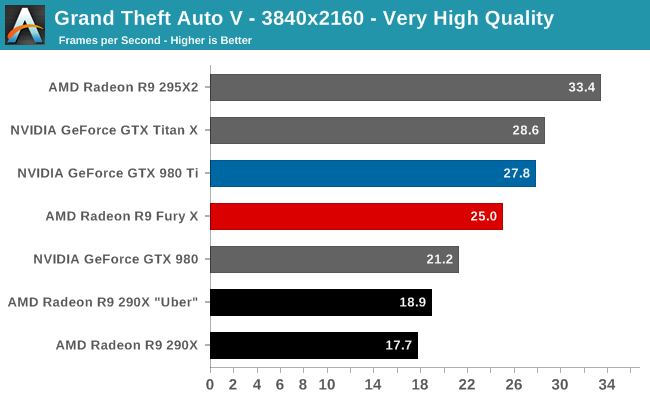
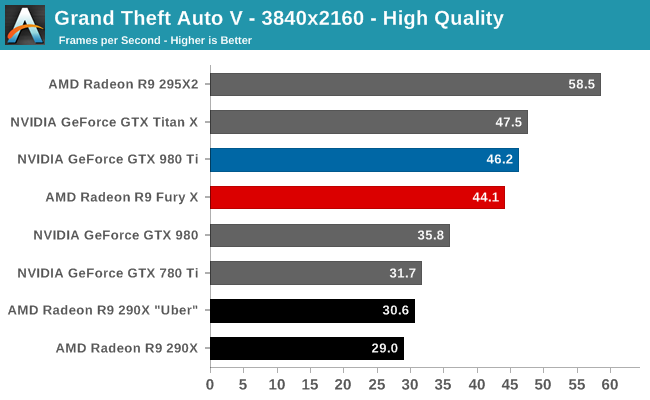
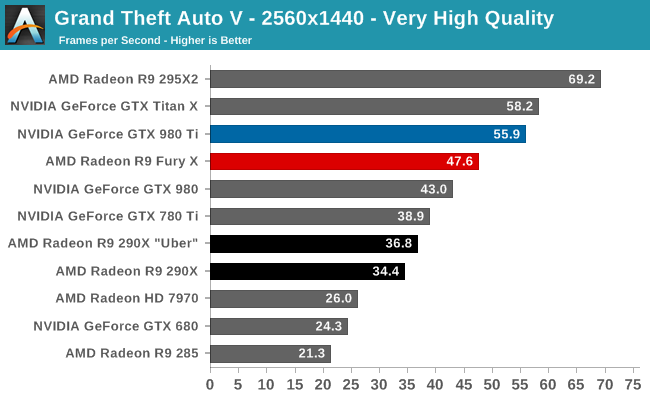
Our final game sees the R9 Fury X go out on either an average or slightly worse than average note, depending on the settings and resolution we are looking at. At our highest 4K settings the R9 Fury X trails the GTX 980 Ti once again, this time by 10%. Worse, at 1440p it’s now 15%. On the other hand if we run at our lower, more playable 4K settings, then the gap is only 5%, roughly in line with the overall average 4K performance gap between the GTX 980 Ti and R9 Fury X.
In this case it’s probably to AMD’s benefit that our highest 4K settings aren’t actually playable on a single GPU card, as the necessary drop in quality gets them closer to NVIDIA’s performance. On the other hand this does reiterate the fact that right now many games will force a tradeoff between resolution and quality if you wish to pursue 4K gaming.
Finally, the performance gains relative to the R9 290X are pretty good. 29% at 1440p, and 44% at the lower quality playable 4K resolution setting.
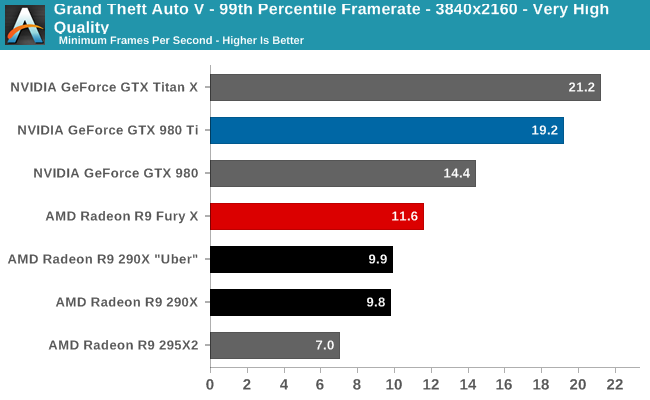
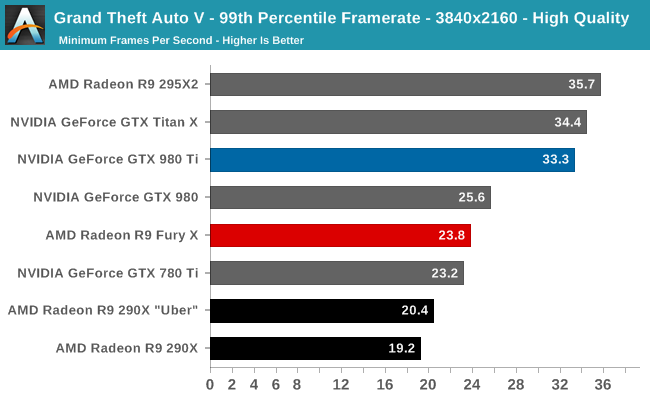
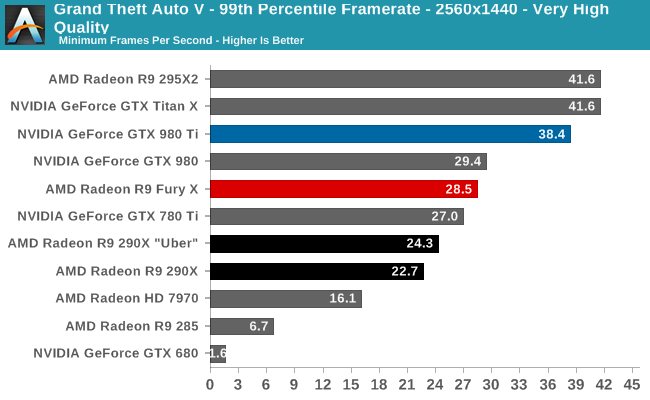
Shifting gears to 99th percentile frametimes however – a much-welcome feature of the game’s built-in benchmark – finds that AMD doesn’t fare nearly as well. At the 99th percentile the R9 Fury X trails the GTX 980 Ti at all times, and significantly so. The deficit is anywhere between 26% at 1440p to 40% at 4K Very High.
What’s happening here is a combination of multiple factors. First and foremost, next to Shadow of Mordor, GTAV is our other VRAM busting game. This, I believe, is why 99th percentile performance dives so hard at 4K Very High for the R9 Fury X, as it only has 4GB of VRAM compared to 6GB on the GTX 980 Ti. But considering where the GTX 980 places – above the R9 Fury X – I also believe there’s more than just VRAM bottlenecking occurring here. The GTX 980 sees at least marginally better framerates with the same size VRAM pool (and a lot less of almost everything else), which leads me to believe that AMD’s drivers may be holding them back here. Certainly the R9 290X comparison lends some possible credit to that, as the 99th percentile gains are under 20%. Regardless, one wouldn’t expect to be VRAM limited at 1440p or 4K without MSAA, especially as this test was not originally designed to bust 4GB cards.










458 Comments
View All Comments
D. Lister - Thursday, July 2, 2015 - link
"AMD had tessellation years before nVidia, but it went unused until DX11, by which time nVidia knew AMD's capabilities and intentionally designed a way to stay ahead in tessellation. AMD's own technology being used against it only because it released it so early. HBM, I fear, will be another example of this. AMD helped to develop HBM and interposer technologies and used them first, but I bet nVidia will benefit most from them."AMD is often first at announcing features. Nvidia is often first at implementing them properly. It is clever marketing vs clever engineering. At the end of the day, one gets more customers than the other.
sabrewings - Thursday, July 2, 2015 - link
While you're right that Nvidia paid for the chips used in 980 Tis, they're still most likely not fit for Titan X use and are cut to remove the underperforming sections. Without really knowing what their GM200 yields are like, I'd be willing to be the $1000 price of the Titan X was already paying for the 980 Ti chips. So, Nvidia gets to play with binned chips to sell at $650 while AMD has to rely on fully up chips added to an expensive interposer with more expensive memory and a more expensive cooling solution to meet the same price point for performance. Nvidia definitely forced AMD into a corner here, so as I said I would say they won.Though, I don't necessarily say that AMD lost, they just make it look much harder to do what Nvidia was already doing and making bookoo cash at that. This only makes AMD's problems worse as they won't get the volume to gain marketshare and they're not hitting the margins needed to heavily reinvest in R&D for the next round.
Kutark - Friday, July 3, 2015 - link
So basically what you're saying is Nvidia is a better run company with smarter people working there.squngy - Friday, July 3, 2015 - link
"and they cost more per chip to produce than AMD's Fiji GPU."Unless AMD has a genie making it for them that's impossible.
Not only is fiji larger, it also uses a totally new technology (HBM).
JumpingJack - Saturday, July 4, 2015 - link
"AMD had tessellation years before nVidia, but it went unused until DX11, by which time nVidia knew AMD's capabilities and intentionally designed a way to stay ahead in tessellation. AMD's own technology being used against it only because it released it so early. HBM, I fear, will be another example of this. AMD helped to develop HBM and interposer technologies and used them first, but I bet nVidia will benefit most from them."AMD fanboys make it sound like AMD can actually walk on water. AMD did work with Hynix, but the magic of HBM comes in the density from die stacking, which AMD did nothing (they are no longer the actual chipmaker as you probably know). As for interposers, this is not new technology, interposers are well established techniques for condensing an array of devices into one package.
AMD deserves credit for bringing the technology to market, no doubt, but their actually IP contribution is quite small.
ianmills - Thursday, July 2, 2015 - link
Good that you are feeling better Ryan and thanks for the review :)That being said Anandtech needs keep us better informed when things come up.... The way this site handled it though is gonna lose this site readers...
Kristian Vättö - Thursday, July 2, 2015 - link
Ryan tweeted about the Fiji schedule several times and we were also open about it in the comments whenever someone asked, even though it wasn't relevant to the article in question. It's not like we were secretive about it and I think a full article of an article delay would be a little overkill.sabrewings - Thursday, July 2, 2015 - link
Those tweets are even featured on the site in the side bar. Not sure how much clearer it could get without an article about a delayed article.testbug00 - Sunday, July 5, 2015 - link
Pipeline story... Dunno title, but, for text, explain it there. Have a link to THG as owned by same company now if readers want to read a review immediately.Twitter is non-ideal.
funkforce - Monday, July 6, 2015 - link
The problem isn't only with the delays, it is that since Ryan took over as Editor in Chief I suspect his workload is too large.Because this also happened with the Nvidia GTX 960 review. He told 5-6 people (including me) for 5 weeks that it would come, and then it didn’t and he stopped responding to inquires about it.
Now in what way is that a good way to build a good relationship and trust between you and your readers?
I love Ryan's writing, this article was one of the best I've read in a long time. But not everyone is good at everything, maybe Ryan needs to focus on only GPU reviews and not running the site or whatever his other responsibilities are as Edit. in Chief.
Because the Reviews are what most ppl. come here for and what built this site. You guys are amazing, but AT never used to miss releasing articles the same day NDA was lifted in the past that I can remember. And promising things and then not delivering, sticking your head in the sand and not even apologizing isn’t a way to build up trust and uphold and strengthen the large following this site has.
I love this site, been reading it since the 1st year it came out, and that's why I care and I want you to continue and prosper.
Since a lot of ppl. can’t reed the twitter feed then what you did here: http://www.anandtech.com/show/8923/nvidia-launches...
Is the way to go if something comes up, but then you have to deliver on your promises.